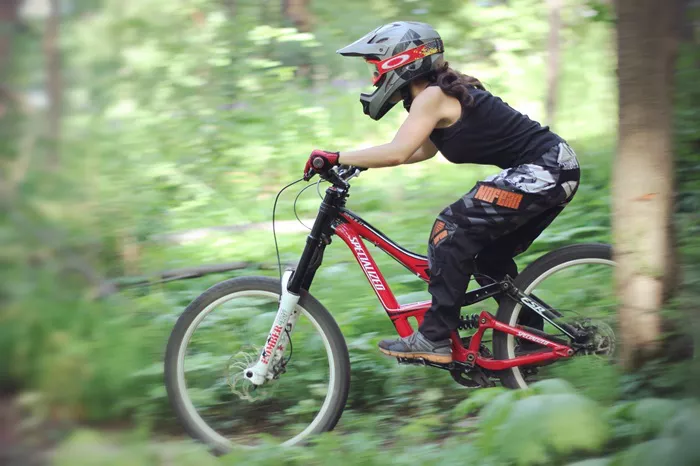Lower back pain is a common issue among mountain bikers, affecting both beginners and seasoned riders. This article explores the various causes of lower back pain while mountain biking and provides practical advice on prevention and treatment.
Anatomy of the Lower Back
To understand why lower back pain occurs during mountain biking, it’s essential to first understand the anatomy of the lower back. The lower back, or lumbar spine, consists of five vertebrae (L1-L5) that support much of the body’s weight. These vertebrae are connected by facet joints, discs, and surrounded by muscles and ligaments that provide stability and mobility. During mountain biking, the lower back undergoes repeated stress and strain, which can lead to pain and discomfort if not properly managed.
Common Causes of Lower Back Pain in Mountain Biking
1. Poor Bike Fit
Saddle Position: Discuss how the height and tilt of the saddle can affect lower back posture and comfort.
Handlebar Height and Reach: The importance of handlebar height and reach in maintaining a neutral spine position.
Frame Size: How choosing the right frame size can prevent overextension and strain on the lower back.
2. Incorrect Riding Posture
Rounding of the Back: The impact of rounding the back while riding, which can compress the lumbar spine and lead to pain.
Arching of the Back: How excessive arching of the back can strain the muscles and ligaments of the lower back.
Neutral Spine Position: Techniques and cues for maintaining a neutral spine throughout various riding conditions.
3. Overuse and Fatigue
Endurance Riding: The cumulative effect of long rides without adequate breaks on the lower back muscles and joints.
High-Intensity Riding: How bursts of intense effort, such as climbing or sprinting, can fatigue the lower back muscles and increase the risk of injury.
4. Muscle Imbalances
Core Weakness: The role of weak core muscles in destabilizing the lower back and causing compensatory movements.
Hip Flexors and Hamstrings: Tightness in these muscles can affect pelvic tilt and lower back posture during riding.
Strengthening Exercises: Specific exercises targeting core, hip, and back muscles to improve stability and reduce the risk of injury.
see also: Which Garmin Watch Is Best For Mountain Biking
5. Impact and Vibration
Trail Conditions: How riding on rough terrain or encountering obstacles can transmit impact forces to the lower back.
Shock Absorption: The importance of suspension systems and tire pressure in reducing vibrations and protecting the spine.
6. Lack of Warm-up and Cool-down
Pre-Ride Warm-up: Dynamic stretches and light exercises to increase blood flow and prepare the muscles for activity.
Post-Ride Stretching: Static stretches to alleviate muscle tension and promote recovery after a ride.
7. Hydration and Nutrition
Dehydration: The effects of dehydration on muscle function and its contribution to cramping and stiffness in the lower back.
Nutritional Support: Guidelines for maintaining electrolyte balance and consuming adequate protein and carbohydrates for muscle recovery.
Preventive Measures
Proper Bike Fit and Adjustment
Professional Bike Fitting: Benefits of consulting with a bike fitting expert to optimize bike geometry for individual biomechanics.
DIY Adjustments: Step-by-step instructions for adjusting saddle height, handlebar position, and other components based on rider feedback.
Core Strengthening Exercises
Core Anatomy: Overview of core muscle groups and their role in supporting the spine and maintaining posture during cycling.
Exercise Progressions: Beginner to advanced exercises, including planks, bridges, and rotational movements, to strengthen the core effectively.
Flexibility and Mobility Training
Dynamic Stretching: Pre-ride routines to improve joint mobility and prepare the body for movement.
Static Stretching: Post-ride stretches targeting major muscle groups to enhance flexibility and prevent tightness.
Posture Awareness
Body Positioning: Techniques for maintaining a balanced and relaxed riding posture while navigating different trail features.
Visual Cues: Using visual landmarks and natural features to adjust body position and maintain optimal spinal alignment.
Rest and Recovery
Active Recovery: Strategies for incorporating low-intensity activities like walking or swimming on rest days to promote circulation and muscle repair.
Sleep and Rest: The role of quality sleep in muscle recovery and overall performance during subsequent rides.
Trail and Gear Adaptations
Bike Selection: Considerations when choosing a bike, including frame material, suspension type, and wheel size, to match riding style and terrain preferences.
Accessory Options: Ergonomic grips, padded shorts, and handlebar extensions that can enhance comfort and reduce strain on the lower back.
Treatment Options for Lower Back Pain
Self-care Techniques
Immediate Relief: Applying ice packs or heat pads to alleviate acute pain and inflammation after a ride.
Pain Management: Over-the-counter medications and topical creams for managing discomfort associated with muscle strain and minor injuries.
Professional Help
Physical Therapy: Benefits of working with a physical therapist to address muscle imbalances, improve biomechanics, and develop a personalized rehabilitation plan.
Chiropractic Care: Spinal adjustments and manual therapy techniques to restore joint mobility and alleviate nerve compression.
Long-term Management
Educational Resources: Online resources and workshops on injury prevention, bike maintenance, and fitness strategies tailored to cyclists.
Progress Monitoring: Keeping a training journal or using fitness apps to track symptoms, performance metrics, and recovery progress over time.
Conclusion
In conclusion, lower back pain can significantly impact a mountain biker’s enjoyment and performance on the trail. By understanding the underlying causes and implementing proactive measures, riders can reduce the risk of injury, improve riding efficiency, and prolong their cycling careers. Remember that prevention and early intervention are key to maintaining a healthy and resilient lower back throughout your mountain biking journey.
related topics:
- How To Dress For Winter Mountain Biking
- What Shoes Are Best For Mountain Biking?
- What Is The Mountain Biking Capital Of The World?

